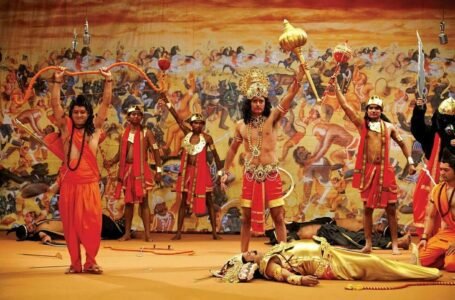The Ribhus: The Forgotten Divine Craftsmen of Vedic Lore

In the vast and intricate pantheon of Vedic mythology, numerous deities and celestial beings occupy roles that shape cosmic order, human destiny, and divine craftsmanship. Among these, the Ribhus stand out as a trio of divine artisans, renowned for their unparalleled skill and ingenuity. Unlike the more widely recognized deities such as Indra, Agni, or Vishnu, the Ribhus have largely faded into obscurity, despite their significant contributions to the shaping of the material and spiritual realms in early Vedic literature. They were once revered as master craftsmen who embodied the very essence of divine creativity, turning the ordinary into the extraordinary. Their mythological feats, including the rejuvenation of old age into youth and the miraculous replication of sacred objects, positioned them as symbols of wisdom, skill, and transformation. However, over time, their prominence waned, and their stories became mere echoes in the vast corpus of Hindu mythology. This article delves into the origins, mythological exploits, symbolic significance, and the eventual decline of the Ribhus, shedding light on a fascinating yet often overlooked aspect of Vedic tradition.
Origins and Identity of the Ribhus
The Ribhus, also spelled as Ribhus or Ribhavas, are three divine artisans known for their supreme craftsmanship. Their names—Ribhu, Vibhvan, and Vaja—appear frequently in the Rigveda, where they are described as sons of Sudhanvan, a mortal. Their mortal birth is significant, as it differentiates them from the gods who were born divine. However, their extraordinary skills in craftsmanship and divine knowledge elevated them to the status of celestial beings, capable of feats beyond human comprehension.
Unlike other deities, who are often portrayed as wielding weapons or governing elements of nature, the Ribhus are predominantly associated with creation and innovation. They are sometimes compared to the Greek god Hephaestus or the Norse dwarves, who were known for their smithing and craftsmanship. In some interpretations, they are also likened to the Ashvins, the twin divine physicians, as both groups share a connection to rejuvenation and transformation.
The Ribhus were closely linked to the solar deity Indra and the sacrificial rituals of the Vedic tradition. They were often invoked for their ability to reshape and refine existing forms, making them indispensable to both gods and humans alike. Their affiliation with the rasa (essence) of things and their ability to mold reality positioned them as divine alchemists, capable of turning the mundane into the miraculous.
The Myths and Miracles of the Ribhus
The Ribhus’ legend is marked by a series of remarkable feats, each illustrating their supreme skill and divine craftsmanship. The Rigveda recounts several episodes in which they display their unparalleled ingenuity, proving themselves worthy of celestial recognition.
The Replication of Indra’s Cup
One of their most famous feats is the replication of Indra’s drinking cup (soma-pātra). Indra, the king of the gods, possessed a celestial goblet used for drinking soma, the sacred nectar of immortality. The Ribhus, in their divine craftsmanship, replicated this cup not once, but four times, making it identical to the original in every detail. This act astonished the gods, as it demonstrated their ability to manipulate divine essence itself.
The replication of Indra’s cup is deeply symbolic, representing the power of artisanship to bridge the human and divine realms. It underscores the idea that true craftsmanship is not just about creating something new, but also about understanding and recreating the divine order with precision and reverence.
The Rejuvenation of Their Parents
Perhaps their most astonishing feat was the rejuvenation of their old parents, turning them into youthful beings once more. This episode highlights the Ribhus’ mastery over the forces of life and transformation. Their ability to reverse aging and restore vitality aligns them with themes of immortality and renewal, concepts central to the Vedic worldview.
The act of rejuvenation symbolizes not just physical restoration but also the revival of wisdom and knowledge. In a broader sense, it reflects the cycle of renewal inherent in Vedic cosmology, where creation and recreation are continuous processes that sustain existence.
The Creation of the Divine Horse and the Chariot
The Ribhus were also credited with the creation of the divine horse (Dadhrik or Dadhikravan), an embodiment of speed and power. This horse was considered to be the prototype of all celestial steeds, showcasing their unparalleled ability to shape living forms with divine precision.
Additionally, they crafted a chariot for the Ashvins, the twin gods of health and medicine. This chariot, unlike any other, was imbued with divine energy, allowing it to traverse both celestial and terrestrial realms. The significance of this creation lies in its association with movement, progress, and the journey of life, themes that are recurrent in Vedic philosophy.
Symbolism and Cultural Significance
The Ribhus, as divine craftsmen, represent the highest ideals of creativity, intellect, and transformation. Their stories emphasize the importance of skill and innovation in maintaining cosmic order. In a spiritual sense, they embody the idea that divinity is not solely about power or warfare, but also about refinement, balance, and the pursuit of perfection.
Their ability to replicate divine objects suggests a deep understanding of cosmic laws, implying that the divine is not exclusive but can be attained through wisdom and mastery. This idea resonates with Vedic traditions that emphasize jnana(knowledge) and karma (action) as pathways to enlightenment.
The Ribhus also serve as a metaphor for the human potential to transcend limitations. Their mortal origins but divine achievements suggest that even ordinary beings, through dedication and skill, can attain divine status. This aligns with Hindu philosophical thought, which often stresses self-improvement and the cultivation of inner divinity.
Despite their remarkable abilities and contributions, the Ribhus gradually faded from mainstream Hindu worship. Unlike deities such as Vishnu or Shiva, they did not develop into personal gods with temples, rituals, or major sects devoted to them. Several factors contributed to this decline:
- Shift in Religious Focus – Over time, Vedic rituals centered around sacrificial worship gave way to devotional theism (bhakti), which emphasized personal relationships with gods like Vishnu, Shiva, and Devi. The Ribhus, being more associated with craftsmanship than divine intervention in human affairs, lost relevance in this evolving religious landscape.
- Lack of Narrative Expansion – Unlike other deities whose myths were expanded upon in later texts like the Puranas, the Ribhus’ stories remained confined to the Vedas. Without continued literary development, their presence diminished in popular consciousness.
- Integration into Broader Mythology – Some aspects of the Ribhus were absorbed into the lore of other divine figures. Their craftsmanship was echoed in the legends of Vishwakarma, the divine architect, who became the predominant figure associated with divine construction and creation.
- Absence of a Devotional Cult – Unlike gods who were worshipped for blessings, protection, or salvation, the Ribhus were revered for their skill. Their lack of direct intervention in human fate may have contributed to their diminishing appeal as objects of devotion.
The Ribhus, once celebrated as master craftsmen of the divine, have become an almost forgotten chapter in Hindu mythology. Their stories, however, continue to resonate with profound themes of creation, transformation, and the pursuit of excellence. They exemplify the idea that skill, intellect, and dedication can bridge the mortal and divine realms, offering a unique perspective within Vedic tradition.
Though their prominence has waned, the legacy of the Ribhus persists in the broader Hindu understanding of craftsmanship and divine artistry. Their myths remind us that the act of creation—whether in art, science, or spirituality—is itself a sacred endeavor, capable of elevating the human spirit to celestial heights. In rediscovering the Ribhus, we not only unearth a forgotten piece of Vedic heritage but also reconnect with a timeless message of ingenuity, renewal, and divine potential.


